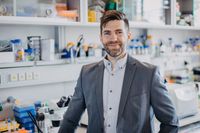Team Members

Dr Markus Diefenbacher
Position Group Leader
Member of > Member of the Comprehensive Cancer Center Mainfranken (CCC) and Graduate School of Life Science, University of Würzburg > Founding member of the Mildred Scheel Junior Research Center Würzburg > Deputy manager BRU (biological resource unit)/animal facility at Biocenter University Würzburg
Teaching > since 2018: Lecture series on ‘Application of in vivo tumour models’ as part of the current MSc program ‘Focus Life Sciences’ of the University of Würzburg > since 2018: Lecture series on ‘Alternatives to animal experiments; 3D models and Organoids’ as part of the current MSc program ‘Focus Life Sciences’ of the University of Würzburg > since 2015: Supervisor in the MSc “Molecular Oncology” lecture series and practical training course of the University of Würzburg
CV More in TEAM

Oliver Hartmann
Position PhD Student
Research Alterations of the Ubiquitin-Proteasome System during oncogenic transformation: An in vivo mouse model to study the role of commonly mutated E3 ligases in NSCLC
Lung cancer is the most common cancer worldwide and the leading cause for cancer related death. Despite the development of novel therapeutic interventions, the 5-year survival rate for NSCLC patients remains low, demonstrating the necessity for novel treatments. One strategy is the development of surrogate models reflecting somatic mutations identified in lung cancer patients. With the advent of CRISPR mediated targeting, gene editing enabled us to model human malignancies in more detail than ever. Tumour cells rely on the ubiquitin system to initiate and maintain oncogenic capacity. Genes encoding putative tumour suppressive E3 ligases, such as APC, KEAP1 or FBXW7 are frequently mutated or lost in tumours, resulting in the dysregulation of proteasome-dependent degradation of oncogenes (e.g., β-Catenin, or c-MYC). By using CRISPR9 mediated gene editing of the tumor suppressors Trp53 and mutation of endogenous KRas to G12D by homologous directed repair, we established a highly versatile murine NSCLC model, being on par with standard GEMM models. Furthermore, with the additional sgRNAs, we recapitulated the genetic complexity of NSCLC and analyzed the impact of loss of function mutations of the E3 ligases APC, KEAP1 and FBXW7 during tumor onset and progression. Deletion of these E3 ligases greatly impacted tumor morphology and burden in vivo, highlighting the potency of these UPS enzymes in lung physiology and transformation. Thus, CRISPR allows for the rapid development of new clinically relevant surrogate models, a requirement for pre-clinical target identification and validation.

